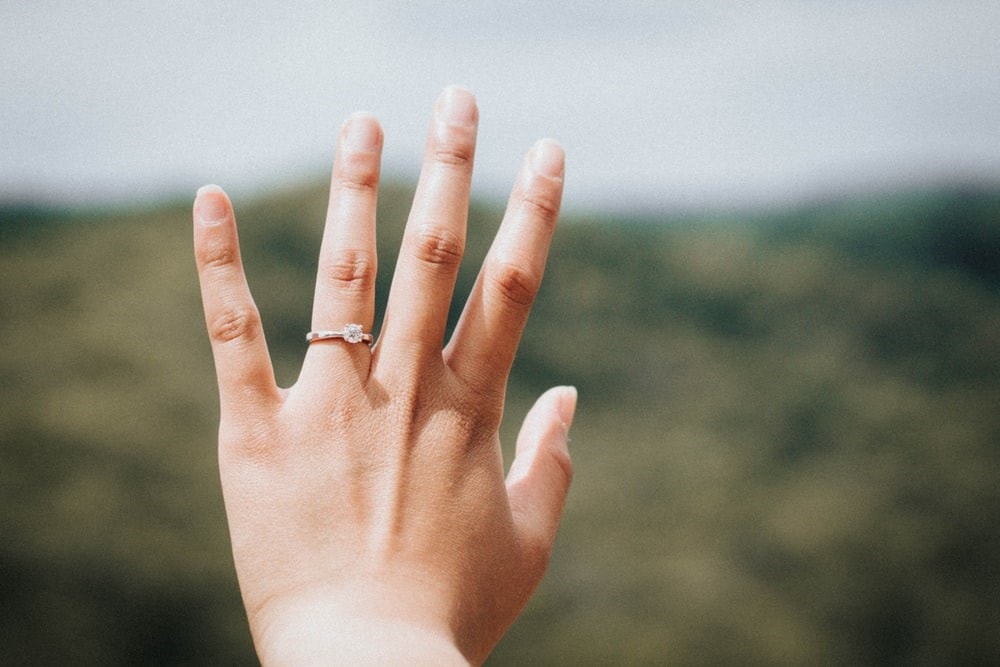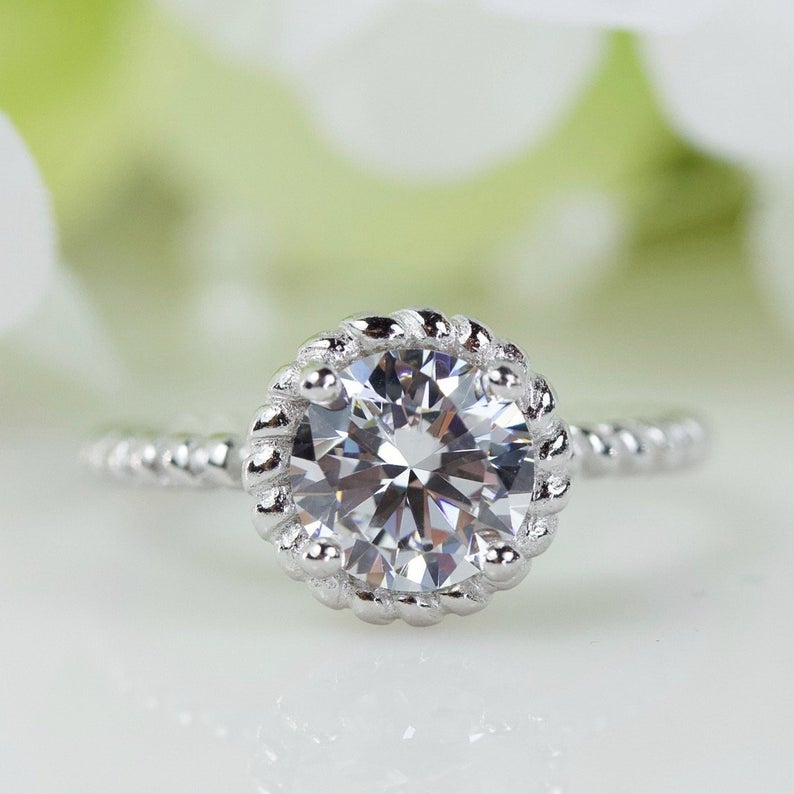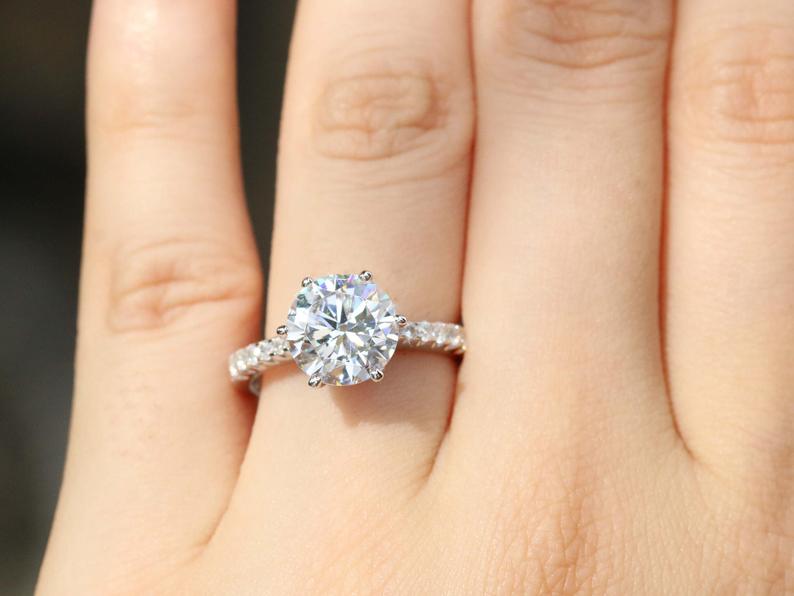
Table of Contents
As Jewelry Shopping Guide editors, we write about things that we love and we think you’ll like too. We often have affiliate partnerships, and may generate some revenue from these links at no cost to you.
If you’re looking into diamond alternatives and substitutes, you’ve likely heard about zirconia. It’s a fairly new gemstone material that was discovered before the start of World War 2 and rose to popularity in the 1970s.
The type of zirconia most people have heard about is Cubic Zirconia. You may have also started hearing about Swarovski Zirconia recently too.
What exactly is that new type of zirconia and how is it different from the “standard” Cubic Zirconia? Let’s take a look at the differences between the two below.
The History of Cubic Zirconia

The history of Cubic Zirconia actually starts in 1892 when the yellowish monoclinic mineral baddaleyite – a natural form of zirconium oxide – was discovered. It has a high melting point of 4976 °F (2750 °C) and it was quickly synthesized into “stabilized zirconia” in 1929. This material was widely used as a refractory material in several industries.
It was in 1937, however, when two German mineralogists – M. V. Stackelberg and K. Chudoba – discovered naturally-occurring Cubic Zirconia in the form of microscopic grains in metamict zircon. At the time, the two Germans viewed it as just a simple byproduct and didn’t even bother to name it.
However, in 1970 Russian scientists at the Lebedev Physical Insstitute in Moscow under V. V. Osiko perfected a technique of control growth of single-crystal Cubic Zirconia. They named the gemstone Fianit after the name of the institute (in Russian – FIAN, i.e. Physical Institute of the Academy of Science or ФИАН “Физический Институт Академии Наук”). To this day Cubic Zirconia is called Fianit in Russia and most of Eastern Europe and that’s arguably its correct name since they were the ones to create it.
The breakthrough was published 3 years later, in 1973, commercial production began in 1976, and by 1977 Cubic Zirconia was already mass-produced in the jewelry world by the Ceres Corporation, the Taiwan Crystal Company, ICT, Swarovski, and others.
Why is Cubic Zirconia Popular?

What made Cubic Zirconia so popular was the fact that it was so similar to diamonds. Most people can’t tell the difference between a well-cut piece of Cubic Zirconia and a diamond. One of the ways to distinguish the two is with 10x magnification – if you look at the edges of Cubic Zirconia’s facets they won’t be as straight as those of a diamond.
Weighing Cubic Zirconia is another way to distinguish it from diamonds because it’s ~60% heavier than the precious stones. A third option is to measure its heat conductivity – Cubic Zirconia will register as red on the indicators while diamonds are green.
Aside from these minor differences, Cubic Zirconia is stunningly similar to diamonds in its appearance – it’s also a very hard gemstone (8 – 8.5 out of 10) even if it’s not as hard as diamonds, it’s very durable, and most importantly – it has amazing brilliance, sparkle, and fire, nearly matching those of diamonds.
All that, together with its much lower price, has made Cubic Zirconia the go-to alternative of diamonds for decades.
What is Swarovski Zirconia?
We mentioned above that Swarovski has been involved in the production of Cubic Zirconium almost from its creation in Moscow. What’s the difference between Cubic Zirconia and Swarovski Zirconia in that case?
In essence, Swarovski Zirconia is a perfected type of Cubic Zirconia. In their efforts to create budget-friendly but high-quality alternatives to diamonds, Swarovski embraced the discovery of Cubic Zirconia and started working on making it as diamond-like as possible.
And they succeeded – Swarovski Zirconia is Cubic Zirconia that’s been cut in the ideal way for maximum sparkle and fire. The Swarovski’s Pure Brilliance Cut has 57 perfect facets that make for fantastic light refraction and brilliance – virtually indistinguishable from even the highest quality diamonds with a naked eye. Even the famous Tolkowsky diamond ideal cut is comparable in beauty and sparkle to Swarovski Zirconia.
That unsurpassed quality of Swarovski Zirconia sets it apart from other diamond imitations into a league of its own – a “diamond imitation” that’s so good that it should be viewed as a “diamond alternative” instead.
All this is very much in line with Swarovski’s mission which is to create “a diamond for everyone”. The classic Swarovski crystals are an even more budget-friendly diamond imitations that were visually distinguishable from diamonds if barely. Swarovski Zirconia is an upgrade to diamonds, however, and it’s an upgrade on them as well as on Cubic Zirconia. As a result of that, Swarovski Zirconia is more expensive than Swarovski crystals and Cubic Zirconia but it’s still significantly cheaper than the authentic diamonds it imitates.
One not with Swarovski Zirconia is that it’s growing so popular in recent years that there are a lot of imitations of it on the market. Yes – imitations of a man-made gemstone that’s itself a diamond imitation. If you want to tell apart Swarovski Zirconia from Cubic Zirconia or from other of its imitations, look for the trapezoid Swarovski logo that’s laser-etched inside the stone. Alternatively, you can look for the official Swarovski seal on the piece’s sticker or tag – the seal is a 16-digit identification code you can verify online. Do not buy Swarovski Zirconia stones or jewelry if this seal is not present.
Which is better?
Simply put, Swarovski Zirconia is a better variant of Cubic Zirconia. It’s also more expensive, however, as it bears the Swarovski brand and is of a higher quality. So, considering that both are good optical imitations of diamonds and both can easily pass the eye test, then Cubic Zirconia is still a good option if you don’t care about branding.
However, given that Swarovski Zirconia is still so budget-friendly compared to actual diamonds, we lean toward it as a better altogether choice. Swarovski Zirconia is such an achievement in man-made gemstones that this raises its quality in and of itself.
With Cubic Zirconia you’ll be purchasing a diamond imitation but with Swarovski Zirconia you’ll be buying a unique item that you can be as happy of owning as with any naturally-grown precious gemstone.









